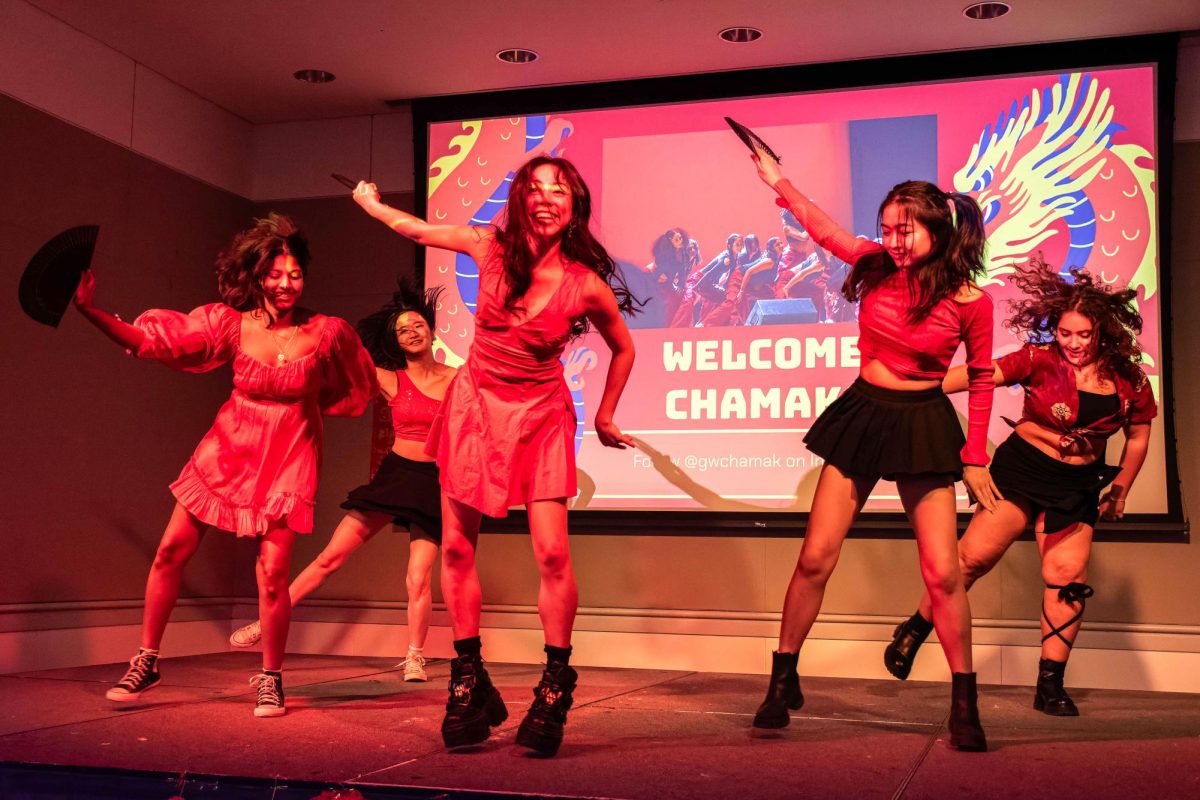GW Chinese American Student Association and Vietnamese Student Association partnered for the first time to host an annual Lunar New Year celebration Saturday, featuring live dance performances, games and lively conversations.
Lunar New Year, also called the Spring Festival, begins on the first new moon of the lunar calendar and is an annual holiday dating back thousands of years where people, primarily in Asian cultures, usher in the new year with festivals to honor ancestors, ward off negative energy and illuminate their homes with lanterns. Students brought the tradition to GW this year by gathering at tables in the University Student Center covered in red lanterns and red and gold streamers — hues meant to bring good fortune — to enjoy traditional eats for the new year like dumplings and banh chung, a Vietnamese sticky rice cake, watch traditional lion dance performances, play games of Mahjong and dine on a buffet of dumplings and spring rolls.
“I want it to just feel like a big family gathering or a big family dinner,” said Michelle Yamamoto, a CASA co-president. “A big part of celebrating the New Year is gathering together with your loved ones and usually having a big banquet. So I just want everybody to feel like they’re in community with one another.”
Yamamoto, a junior, said CASA and VSA usually put on separate New Year’s celebrations but decided to join forces this year to combine their resources and funding to put on more performances and activities for guests. She added that she wanted to build community with other Asian student groups on campus, which she felt hadn’t happened enough in the past.
There has been a global push over the past decade to embrace Vietnamese, Korean and Malaysian cultures into the Lunar New Year celebrations by using “Lunar New Year” instead of “Chinese New Year” to refer to the holiday.
Students kicked off the banquet with an interactive lion dance performance from the D.C.-based Hung Ci Lion Dance Troupe. One dancer wore a decorated lion head and other dancers braced the body to tell the story of the beast “Nian” — the center of Lunar New Year legends.
Chamak, a multicultural fusion dance team, performed a dance to traditional Chinese music with black fans following the lion dance. Senior Siyu Wang closed out the performances with a traditional Chinese dance, donning a flowing red and green dress.
Yamamoto said this year’s celebration continued the tradition of lion dancing, part of a Chinese ceremony during the new year to dispel evil and included new performances from groups like Chamak. She said the Lunar New Year gives Asian American students a sense of comfort because they can celebrate part of their culture while far from home and family.
“It’s so traditional to celebrate Lunar New Year with your family, so when you’re at school and really far away from your family and what you are used to it can feel a little bit isolating,” Yamamoto said. “I want people to be able to come and feel like they have a community even if they’re not at home celebrating with the people that they’re used to.”
First-year Caitlyn Huynh-Nguyen, VSA’s marketing intern, said CASA contacted VSA about collaborating on the event over winter break.
“We are so privileged to be collaborating with CASA, which is such a huge social culture organization on campus,” Huynh-Nguyen said.
Huynh-Nguyen said the event offered envelope decorating to build off an East Asian tradition of elders giving younger relatives money in envelopes for the new year. She said they also included traditional Vietnamese games like bầu cua cá cọp, where students rolled dice stamped with animals and used candy as substitutes for money to bet on which animal the dice would land on.
Huynh-Nguyen said she wanted Asian Americans on campus to have an opportunity to not only celebrate their heritage but also include all students in the annual celebration.
“Hopefully we can have not only Vietnamese and Asian Americans come to this event, but also anybody because it’s open to everybody,” Huynh-Nguyen said. “We want to be able to share our culture with others and not just Asian Americans.”
Junior Nadia Primer, Chamak’s president, said the group’s fan dance performance to Chinese pop song “Jì Míngyuè” — which translates to “Moonlight Thoughts” — included classic Lunar New Year elements, such as the incorporation of fans and the color red, as well as modern Chinese culture. Primer said Chamak integrates modern dances from multiple cultures globally into their performances to highlight different cultural styles of movement.
“That’s what Chamak is all about, is instead of just seeing people dance and represent their own culture, you’re also seeing them dance and appreciate other cultures as well,” Primer said.
Junior Natalie Wong, a Chinese exchange student, said she normally celebrates the new year in China and decided to come to the event to meet new people and celebrate her culture.
“It reminds me of my family because we celebrate Chinese New Year together,” Wong said. “It’s a time where everybody, friends and family come together, so I’m excited to celebrate here at GW even though I’m far away from home.”
First-year Lisbel So said the celebration brings back fond childhood memories of past Lunar New Year celebrations with her family.
“When I was little, there was lion dancers and my parents would usually give me red envelopes, and I’d have to give it to the performers,” So said. “It was a sign of good luck or prosperity.”




